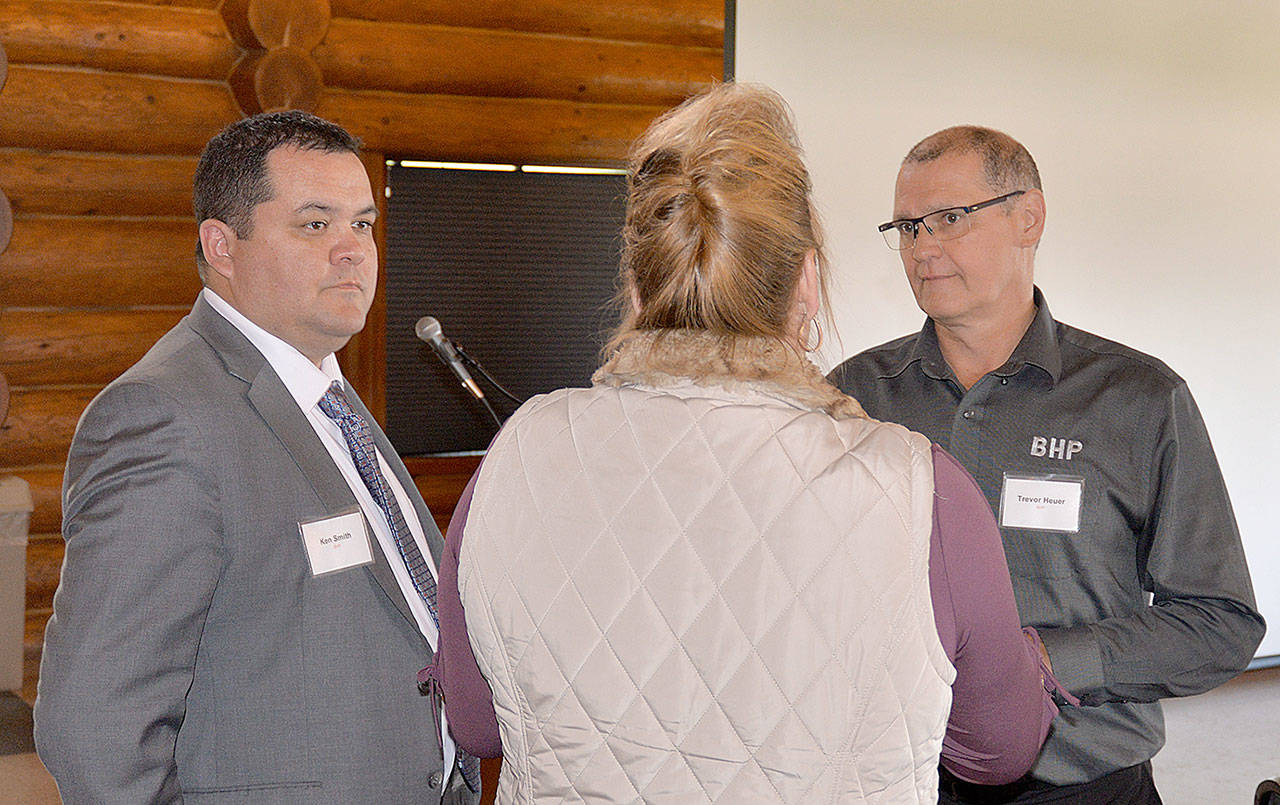Train traffic, economic impacts and environmental questions about the proposed potash shipping facility at Port of Grays Harbor Terminal 3 were addressed by representatives of BHP at Greater Grays Harbor Inc.’s monthly business forum lunch at the Rotary Log Pavilion in Aberdeen Tuesday.
BHP, the global mining company behind the proposed facility, was represented by Manager of Corporate Affairs Ken Smith and Study Manager Trevor Heuer.
This was one of several stops on the current public outreach program the company has undertaken since it began considering the Hoquiam as one of two possible locations for the facility, which would receive potash – a potassium-based product used in the production of agricultural fertilizer – from the company’s Jansen Mine in Saskatchewan, Canada, via rail for shipment to overseas markets.
Heuer talked about the proposed facility, which would include a rail car unloading facility, a conveyor system, potash storage building, administration and maintenance buildings, and a ship loading facility.
The facility, when at full production, would mean an additional eight to 10 trains, each about a mile long, per week traveling through Aberdeen to the Port. To minimize the impacts, Heuer said the facility includes a 3-mile train loop, which can facilitate up to three unit trains inside the facility itself.
As for how the facility would impact overall rail traffic in the community, when at full production, Heuer said, “Rail traffic would nearly double with the potash cars coming through.”
As far as environmental impacts, Heuer said the company has undertaken dozens of mitigation steps to minimize those impacts. The train cars carrying the potash are loaded at the mine, sealed, travel straight to the facility to a covered rail car unloading facility, dropped onto covered conveyors, and transported either to the onsite storage facility or directly to awaiting vessels. This protects the water-soluble product from the weather, and also minimizes dust emissions, and minimizes the noise created by the facility’s operations.
Heuer said at the vessel dock there will be a “cascade chute, so there will be no free-fall of potash onto the vessel,” another dust-mitigating move. “It’s a very contained process to minimize the environmental impact.”
Noise was a concern heard during the many meetings with stakeholders across the region, particularly with the facility’s proximity to the Grays Harbor National Wildlife Refuge. Heuer said feedback early on prompted the company to move the rail car unloading facility to the east side of the property, away from the refuge.
Economic impacts include the $400 million price tag to construct the facility, said Smith, and the estimated 40-50 “full-time and casual positions” filled to run it, said Heuer.
“What they are projecting the construction cost to be would basically equal the assessed value of the City of Hoquiam,” said Gary Nelson, Executive Director of the Port of Grays Harbor, who was in attendance. He added that BHP would pay a lease hold excise tax, “equivalent to a property tax” and “based on the value of the lease.” Additionally BHP would pay a personal property tax on the value of the improvements to the property, including buildings and equipment.
Smith said the company is in the middle of the site’s permitting process. Written public comment will be accepted by the City of Hoquiam on its shorelines application through Oct. 14; documents are available online at cityofhoquiam.com under public notices. Written comments can be mailed in care of Brian Shay, City of Hoquiam, 609 8th St., Hoquiam, WA 98550 or emailed to bshay@cityofhoquiam.com. Smith said a public hearing on the application is tentatively scheduled for Oct. 24.


